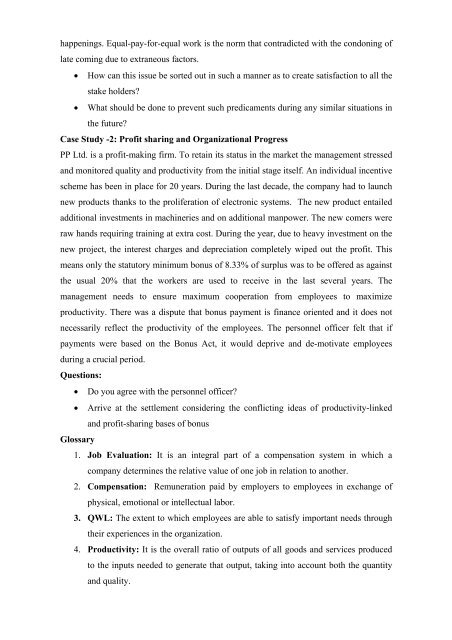UNIT – I Lesson 1 HRM – AN OVERVIEW Lesson Outline Nature of ...
UNIT – I Lesson 1 HRM – AN OVERVIEW Lesson Outline Nature of ...
UNIT – I Lesson 1 HRM – AN OVERVIEW Lesson Outline Nature of ...
Create successful ePaper yourself
Turn your PDF publications into a flip-book with our unique Google optimized e-Paper software.
happenings. Equal-pay-for-equal work is the norm that contradicted with the condoning <strong>of</strong><br />
late coming due to extraneous factors.<br />
• How can this issue be sorted out in such a manner as to create satisfaction to all the<br />
stake holders?<br />
• What should be done to prevent such predicaments during any similar situations in<br />
the future?<br />
Case Study -2: Pr<strong>of</strong>it sharing and Organizational Progress<br />
PP Ltd. is a pr<strong>of</strong>it-making firm. To retain its status in the market the management stressed<br />
and monitored quality and productivity from the initial stage itself. An individual incentive<br />
scheme has been in place for 20 years. During the last decade, the company had to launch<br />
new products thanks to the proliferation <strong>of</strong> electronic systems. The new product entailed<br />
additional investments in machineries and on additional manpower. The new comers were<br />
raw hands requiring training at extra cost. During the year, due to heavy investment on the<br />
new project, the interest charges and depreciation completely wiped out the pr<strong>of</strong>it. This<br />
means only the statutory minimum bonus <strong>of</strong> 8.33% <strong>of</strong> surplus was to be <strong>of</strong>fered as against<br />
the usual 20% that the workers are used to receive in the last several years. The<br />
management needs to ensure maximum cooperation from employees to maximize<br />
productivity. There was a dispute that bonus payment is finance oriented and it does not<br />
necessarily reflect the productivity <strong>of</strong> the employees. The personnel <strong>of</strong>ficer felt that if<br />
payments were based on the Bonus Act, it would deprive and de-motivate employees<br />
during a crucial period.<br />
Questions:<br />
• Do you agree with the personnel <strong>of</strong>ficer?<br />
• Arrive at the settlement considering the conflicting ideas <strong>of</strong> productivity-linked<br />
and pr<strong>of</strong>it-sharing bases <strong>of</strong> bonus<br />
Glossary<br />
1. Job Evaluation: It is an integral part <strong>of</strong> a compensation system in which a<br />
company determines the relative value <strong>of</strong> one job in relation to another.<br />
2. Compensation: Remuneration paid by employers to employees in exchange <strong>of</strong><br />
physical, emotional or intellectual labor.<br />
3. QWL: The extent to which employees are able to satisfy important needs through<br />
their experiences in the organization.<br />
4. Productivity: It is the overall ratio <strong>of</strong> outputs <strong>of</strong> all goods and services produced<br />
to the inputs needed to generate that output, taking into account both the quantity<br />
and quality.
















